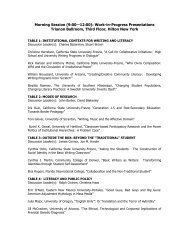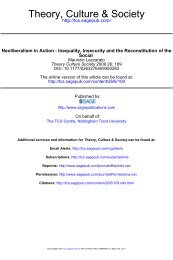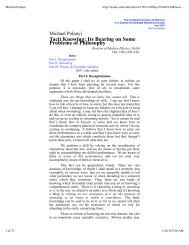PUBLIC OPINION by WALTER LIPPMANN TO FAYE LIPPMANN ...
PUBLIC OPINION by WALTER LIPPMANN TO FAYE LIPPMANN ...
PUBLIC OPINION by WALTER LIPPMANN TO FAYE LIPPMANN ...
Create successful ePaper yourself
Turn your PDF publications into a flip-book with our unique Google optimized e-Paper software.
to be easily popular where the marking is not definite and the choice<br />
clear. [Footnote: A fact which bears heavily on the character of news.<br />
_Cf_. Part VII.] But that is not enough. The audience must have<br />
something to do, and the contemplation of the true, the good and the<br />
beautiful is not something to do. In order not to sit inertly in the<br />
presence of the picture, and this applies as much to newspaper stories<br />
as to fiction and the cinema, the audience must be exercised <strong>by</strong> the<br />
image. Now there are two forms of exercise which far transcend all<br />
others, both as to ease with which they are aroused, and eagerness<br />
with which stimuli for them are sought. They are sexual passion and<br />
fighting, and the two have so many associations with each other, blend<br />
into each other so intimately, that a fight about sex outranks every<br />
other theme in the breadth of its appeal. There is none so engrossing<br />
or so careless of all distinctions of culture and frontiers.<br />
The sexual motif figures hardly at all in American political imagery.<br />
Except in certain minor ecstasies of war, in an occasional scandal, or<br />
in phases of the racial conflict with Negroes or Asiatics, to speak of<br />
it at all would seem far-fetched. Only in moving pictures, novels, and<br />
some magazine fiction are industrial relations, business competition,<br />
politics, and diplomacy tangled up with the girl and the other woman.<br />
But the fighting motif appears at every turn. Politics is interesting<br />
when there is a fight, or as we say, an issue. And in order to make<br />
politics popular, issues have to be found, even when in truth and<br />
justice, there are none,--none, in the sense that the differences of<br />
judgment, or principle, or fact, do not call for the enlistment of<br />
pugnacity. [Footnote: _Cf_. Frances Taylor Patterson, _Cinema<br />
Craftsmanship_, pp. 31-32. "III. If the plot lacks suspense: 1. Add<br />
an antagonist, 2. Add an obstacle, 3. Add a problem, 4. Emphasize one<br />
of the questions in the minds of the spectator.,.."]<br />
But where pugnacity is not enlisted, those of us who are not directly<br />
involved find it hard to keep up our interest. For those who are<br />
involved the absorption may be real enough to hold them even when no<br />
issue is involved. They may be exercised <strong>by</strong> sheer joy in activity, or<br />
<strong>by</strong> subtle rivalry or invention. But for those to whom the whole<br />
problem is external and distant, these other faculties do not easily<br />
come into play. In order that the faint image of the affair shall mean<br />
something to them, they must be allowed to exercise the love of<br />
struggle, suspense, and victory.<br />
Miss Patterson [Footnote: _Op. cit._, pp. 6-7.] insists that<br />
"suspense... constitutes the difference between the masterpieces in<br />
the Metropolitan Museum of Art and the pictures at the Rivoli or the<br />
Rialto Theatres." Had she made it clear that the masterpieces lack<br />
either an easy mode of identification or a theme popular for this<br />
generation, she would be wholly right in saying that this "explains<br />
why the people straggle into the Metropolitan <strong>by</strong> twos and threes and





